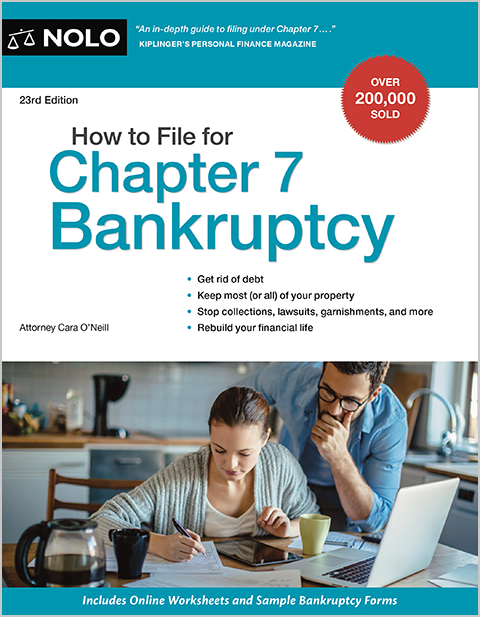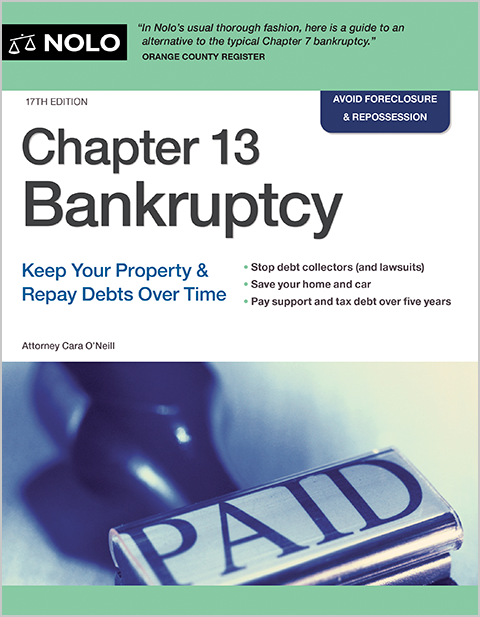In Chapter 7 bankruptcy, if you don’t want to keep an item of property that serves as collateral for a secured debt, you can “surrender" it.
When filing for Chapter 7 bankruptcy, you must decide how to handle mortgages, car loans, and other "secured debts" backed by collateral, and "surrendering secured property" is the simplest option. When you surrender secured property in Chapter 7, you return the home, car, or other collateral to the lender and eliminate your responsibility to pay for it in the bankruptcy case. This article explains the benefits and drawbacks of surrendering property, as well as the requirements you must meet when you'd like to keep the property.
- Advantages of Surrendering Property in Chapter 7 Bankruptcy
- Disadvantages of Surrendering Property in Bankruptcy
- Other Types of Secured Debts
- Filing the Form for Surrendering Secured Property in Chapter 7
- When to Surrender the Property to the Creditor
- Understanding Secured Debt and Property in Chapter 7 Bankruptcy
- When You Don't Want to Surrender Financed Property In Chapter 7
- Need More Bankruptcy Help?
Advantages of Surrendering Property in Chapter 7 Bankruptcy
Surrendering property in Chapter 7 is one of the simplest methods of dealing with secured debt and property in Chapter 7. The lender receives the property back, and the bankruptcy discharge wipes out your liability for the secured loan. Opting to surrender property allows you to wash your hands of it and walk away without payment responsibility. It's a good way to go if you no longer want or need the property. It's also a helpful approach if the property is a financial liability you'd rather not have or you can't afford to continue making payments.
Example. Suppose you were making payments on a car with a blown engine. A simple way to resolve the issue would be to return the vehicle to the lender. Find out more about surrendering a car in Chapter 7 bankruptcy.
Disadvantages of Surrendering Property in Bankruptcy
No one wants to return property that they love, so it won't come as a surprise that the most obvious disadvantage to surrendering property is that you lose the property itself. If you were to surrender a home, you'd need to find another place to live before filing because renting can be difficult for a few years after bankruptcy. If it were a car, you'd need a replacement.
As much as you might like to get out from under a hefty payment, surrendering the property might not be an option in some cases. For instance, if you need your car to go to work or attend doctor's appointments, and you don't have another way of obtaining transportation, the best course of action might be to keep it.
A less obvious disadvantage to surrendering property is that some courts won't count your loan payments on property you intend to surrender for purposes of the means test. Because secured payments reduce your available disposable income for qualification purposes, not being able to deduct the loan amount from your income might make it more challenging to qualify for Chapter 7 bankruptcy.
Other Types of Secured Debts
If you've gotten this far, you likely fully understand that if you don't continue to pay for a financed car or home in Chapter 7, you can't keep it. You should know that even if you continue to make payments, you have an additional hurdle: You must protect any equity from the Chapter 7 trustee with bankruptcy exemptions. Otherwise, the trustee will sell the property.
But cars and homes aren't the only types of secured property you might need to deal with in Chapter 7. You might have financed other items without knowing that you voluntarily agreed to give the lender a lien. If you are still paying for jewelry, electronics, large appliances, furniture, or mattresses, you'll want to check the receipt or contract because it's likely a secured debt.
For instance, when you purchase "rent-to-own" furniture and appliances, the agreement will state that the store retains a security interest in your new couch or TV until you complete the payments. The clause gives the store the right to repossess it if you fall behind on payments. Similarly, if you made a large purchase on a store credit card, you probably agreed that a lien would remain on the item until you paid it off.
It's also common to have a lien placed on your property without your consent—and sometimes, without your knowledge. For instance, the IRS, your homeowners association (HOA), or a utility company might have secured its debt by placing a lien on your property. Other forms of liens include nonconsensual judgment liens after a trial verdict and mechanics liens. You'll need to deal with all of these secured debts and liens in Chapter 7.
Learn when you can eliminate a judgment lien in bankruptcy.
Filing the Form for Surrendering Secured Property in Chapter 7
If you decide to surrender property in Chapter 7, you'll inform the court on the Statement of Intention for Individuals Filing Under Chapter 7 form. You'll have time to think about what to do because you don't have to file the form until the sooner of the following: 30 days after filing for bankruptcy or the date first set for the 341 meeting of creditors.
However, suppose you don't file it on time. In that case, the automatic stay order that prevents the creditor from foreclosing or repossessing the property lifts, and the creditor can proceed (although most creditors file a motion to lift the stay beforehand to verify that the stay indeed lifted).
When to Surrender the Property to the Creditor
You can agree to a time and place to surrender the property, which many filers do. Still, ultimately, the creditor must recover it. If the creditor doesn't retrieve or take possession of the property (and the trustee doesn't sell it), you keep it. However, this doesn't happen often, so it isn't a strategy to count on, although the likelihood of it occurring is higher when the property isn't worth much.
Understanding Secured Debt and Property in Chapter 7 Bankruptcy
A secured debt is an obligation that is attached to an item of property, often called collateral. The collateral guarantees the debt's payment because if the borrower defaults on the loan, the creditor can repossess (take) the property. Examples of secured debt include car loans, mortgages, and loans for household appliances and furniture, where the seller keeps a security interest in the property.
When you have a secured debt, your liability is twofold. You're personally liable for the loan amount, so the creditor can sue you for the money you owe if you don't pay. But the secured creditor also has a lien that attaches to the property, so you can lose the property, as well.
Here's how this works in Chapter 7 bankruptcy. When you file, the discharge eliminates your liability to pay the debt, so the creditor can't collect the amount you owe. But, in most cases, you can't use bankruptcy to get rid of a lien (although some exceptions exist). Because the lien remains, the lender can recover the property.
When You Don't Want to Surrender Financed Property In Chapter 7
In Chapter 7 bankruptcy, you must meet two specific sets of requirements to keep property because both the Chapter 7 trustee and the creditor will evaluate whether they can recover it. The Chapter 7 trustee will be checking whether all of the equity is exempt. If you have equity in the property that is not exempt, the trustee will likely sell the property to pay your unsecured creditors.
If you don't have any property equity, or if it's all exempt, you might be able to keep a financed property if you can afford to pay for it. Otherwise, the lender will recover it. You'll likely have several options, including continuing to make the loan payments or buying the property from the creditor.
Learn more about options for keeping a car in Chapter 7 and what to do if you want to keep your home in bankruptcy.
Need More Bankruptcy Help?
Did you know Nolo has made the law accessible for over fifty years? We wholeheartedly encourage research and learning, and you can find many more helpful bankruptcy articles on Nolo's bankruptcy homepage. Additionally, information needed to complete the official downloadable bankruptcy forms is on the Department of Justice U.S. Trustee Program website.
However, online articles and resources can't address all bankruptcy issues and aren't written with the facts of your particular case in mind. The best way to protect your assets in bankruptcy is by hiring a local bankruptcy lawyer.
|
|
- Advantages of Surrendering Property in Chapter 7 Bankruptcy
- Disadvantages of Surrendering Property in Bankruptcy
- Other Types of Secured Debts
- Filing the Form for Surrendering Secured Property in Chapter 7
- When to Surrender the Property to the Creditor
- Understanding Secured Debt and Property in Chapter 7 Bankruptcy
- When You Don’t Want to Surrender Financed Property In Chapter 7
- Need More Bankruptcy Help?

